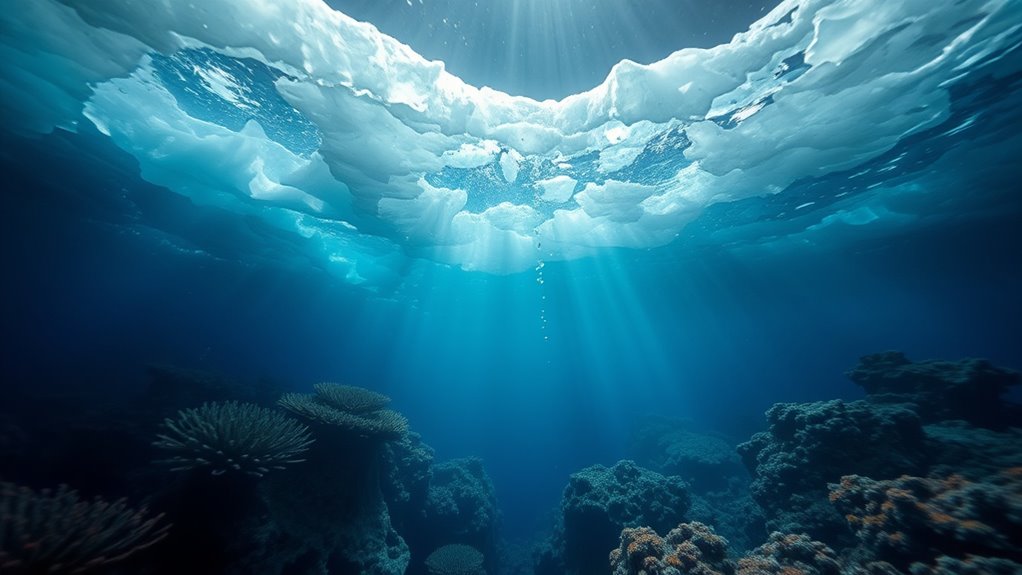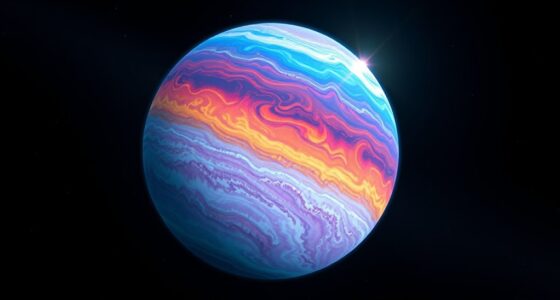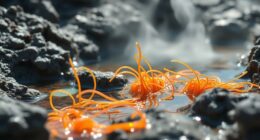Recent findings reveal strong evidence that Europa has a vast, salty subsurface ocean hidden beneath its thick ice shell. Magnetic data and surface features indicate an electrically conductive saltwater layer, likely kept warm by Jupiter’s tidal forces. Surface chaos terrains and chemical signatures suggest ongoing exchange between the ocean and ice. If you explore further, you’ll discover more about how this hidden ocean may support life and the exciting missions aiming to confirm it.
Key Takeaways
- Europa’s magnetic field indicates the presence of a conductive, salty subsurface ocean beneath its ice shell.
- Surface ice features and chaos terrains suggest active geological processes connecting the surface to a hidden ocean.
- Detection of ocean-related materials like sodium chloride and hydrogen peroxide supports the existence of a liquid beneath the ice.
- Tidal heating from Jupiter likely maintains the ocean in a liquid state beneath a possibly thick ice shell.
- Upcoming missions like Europa Clipper aim to gather direct evidence of the ocean’s composition and habitability potential.

Could there be a vast, hidden ocean beneath Europa’s icy surface? Recent evidence strongly suggests so. Jupiter’s magnetic field interacts with Europa, inducing a magnetic signature that indicates a layer of electrically conductive fluid beneath the ice. This points to a salty, liquid ocean lurking below, kept warm by tidal forces from Jupiter’s gravity. Surface ice studies reveal that ice crystallizes at varying rates across different regions, hinting at active geology and possible exchanges between the surface and the subsurface ocean. Features like chaos terrains, which include ridges, cracks, and plains, further support this idea. These complex surface modifications imply ongoing geological processes, possibly driven by the ocean’s influence. Additionally, scientists have detected materials such as sodium chloride, carbon dioxide, and hydrogen peroxide near regions where ice appears recrystallized. These substances likely originate from the ocean, transported upward through fractures or plumes, signaling ongoing interactions beneath the surface. The thickness of Europa’s ice shell, however, remains a point of debate. It appears thicker than initially assumed, which could limit heat flow and reduce the likelihood of a highly active ocean. Still, even a thick ice layer doesn’t necessarily mean the ocean isn’t there; it might just be more isolated than once thought. This ice layer is constantly affected by external radiation and internal heat sources, which influence surface chemistry and structure. Recent studies also suggest that ice dynamics could play a significant role in shaping Europa’s surface features over time. The composition of Europa’s ocean raises the exciting possibility that it contains all the essential ingredients for life. Water, energy sources, and chemical nutrients could create a habitable environment beneath the ice. Yet, the presence of hydrothermal vents or seafloor volcanoes—key features that could supply energy and nutrients—is still uncertain. Scientists are keen to understand if such features exist, as they could considerably boost the potential for life. Plumes, which might carry microbes from the ocean to space, are another focus of investigation. While evidence for these plumes remains inconclusive, their detection would be a breakthrough, allowing us to analyze oceanic materials directly. Future missions, like the Europa Clipper launched in 2024, aim to explore these mysteries. The spacecraft will fly multiple close passes, using instruments designed to study surface composition, map geological features, and search for plumes, all before arriving at its science goals around 2030.
The surface of Europa isn’t static. It constantly evolves due to interactions between charged particles from Jupiter’s magnetosphere and the ice. These external forces cause the ice to amorphize and recrystallize, creating the chaos terrains and other features observed. Laboratory experiments help constrain how quickly these transformations happen, especially in regions where the surface appears fractured or disturbed. Recent observations from the James Webb Space Telescope support the idea of a dynamic, interacting surface and subsurface. Spectral data reveal changes in ice structure consistent with ongoing interactions with a subsurface ocean. Altogether, these clues paint a compelling picture: beneath Europa’s icy crust lies a hidden ocean, rich with potential and awaiting further exploration.
Frequently Asked Questions
Could Life Exist in Europa’S Hidden Ocean?
You wonder if life could exist in Europa’s hidden ocean. Given the presence of liquid water, essential elements like carbon, sulfur, and salts, and energy sources from tidal heating and hydrothermal activity, conditions seem promising. The ocean’s chemistry and stability beneath the ice provide a potential habitat for extremophiles or life forms similar to those on Earth’s deep-sea vents. So, yes, Europa’s ocean might just be a viable place for life to thrive.
How Deep Is Europa’S Subsurface Ocean?
You’re wondering how deep Europa’s subsurface ocean is. Scientists estimate it’s around 100 kilometers deep, making it incredibly vast—more water than all Earth’s oceans combined. This ocean is hidden beneath a thick icy crust and lies between the moon’s rocky interior and ice shell. Tidal heating from Jupiter keeps it in a liquid state, creating a potential environment for life and further exploration.
What Tools Are Used to Explore Europa’S Ocean?
Ever wonder how scientists peek beneath Europa’s icy shell? You’ll find they use a variety of tools like the Europa Clipper Magnetometer to detect magnetic signals indicating a subsurface ocean, and ice-penetrating radar to map beneath the ice. Instruments like spectrometers analyze surface and atmospheric composition, while flybys gather detailed data without risking prolonged exposure. These tools together help reveal Europa’s hidden ocean and its potential for life.
When Might Future Missions to Europa Occur?
You’re wondering when future missions to Europa might happen. Based on current plans, the Europa Clipper will arrive at Jupiter in 2030 and start detailed flybys of Europa in 2031. Future missions, including potential landers or subsurface probes, depend on the data from Clipper and JUICE. While exact timelines aren’t set, these missions could take place in the 2030s or later, advancing our understanding of Europa’s hidden ocean.
Are There Any Signs of Current Geological Activity?
You’re wondering if there are signs of current geological activity on Europa. Evidence points to recent surface changes, like chaotic terrains, cracks, and ridges, suggesting ongoing resurfacing. Transient water vapor plumes detected by the Hubble Space Telescope indicate venting from the subsurface, which implies active processes. These signs, combined with Europa’s youthful terrain and internal heating from tidal flexing, strongly suggest that geological activity continues today beneath the icy shell.
Conclusion
As you look at Europa’s icy surface, remember that every discovery peels back a layer of the unknown. The latest evidence of a hidden ocean beneath the ice is like opening a door to a secret world, waiting to be explored. Keep in mind, “the more you learn, the more you realize you don’t know,” and just like an iceberg, there’s so much beneath the surface yet to be uncovered. The universe’s mysteries are waiting for you.










